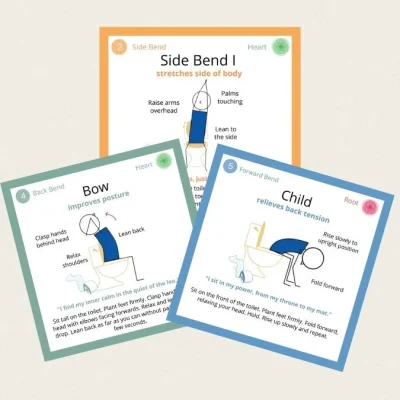In this post, we’re going to unlock the secrets of teaching Dolphin Pose (Ardha Pincha Mayurasana) with this mini guide for yoga teachers.
In this mini guide you’ll get your yoga teaching hands on step-by-step instructions, 30 beginner-to-advanced modifications, and 10 teaching tips to help your students build strength, stability, and confidence in this transformative pose.
This is a marvellous mini guide for teaching dolphin pose. Ready? Let’s start with the six teaching steps.
Dolphin Pose: In 6 Teaching Steps

How To Teach Dolphin Pose
Below, are the 6 teaching steps for Dolphin pose.
Step 1: Hands & Knees
Start on your hands and knees in a tabletop position.
Step 2: Forearms On Mat
Place your forearms on the mat, shoulder-width apart, with palms flat.
Step 3: Lift Your Hips
Tuck your toes and lift your hips towards the ceiling, coming into an inverted “V” shape.
Step 4: Press Forearms Into Mat
Engage your core and press your forearms into the mat to lift your chest.
Step 5: Head Between Upper Arms
Keep your head between your upper arms, avoiding tension in the neck.
Step 6: Breath Deeply
Hold the pose while breathing deeply, maintaining stability through your shoulders and core.
Dolphin Pose: 10 Teaching Tips

Dolphin Pose Teaching Tips
Below, are 10 teaching tips for Dolphin pose.
Tip 1: Elbow Alignment Matters
Ensure the elbows are shoulder-width apart and directly under the shoulders. This helps to avoid collapsing into the upper body and promotes stability in the pose.
Tip 2: Engage Your Core
Encourage students to activate their core muscles, drawing the belly button in towards the spine. A strong core will help maintain balance and prevent unnecessary strain on the lower back.
Tip 3: Spread Your Fingers
Fingers should be spread wide, with weight evenly distributed across the palms. This creates a stable base and allows energy to flow more freely through the arms and shoulders.
Tip 4: Lengthen The Spine
Focus on creating length through the spine, especially in the neck and lower back. A long spine helps maintain alignment and prevents compression in the lower back during the pose.
Tip 5: Avoid Overarching The Back
Ensure the lower back isn’t overarched by guiding students to soften the ribs and gently tuck the pelvis. A small pelvic tilt helps protect the lower back and creates a more stable base.
Tip 6: Press Through The Forearms
Instruct students to press their forearms firmly into the mat to activate the shoulders. This reduces strain on the wrists and encourages proper shoulder alignment.
Tip 7: Lift The Hips High
The hips should be lifted towards the ceiling, aiming for a V-shaped position. This creates more space in the spine and helps to open the shoulders and chest.
Tip 8: Look Towards The Toes
Encourage students to look towards their toes or slightly back to avoid straining the neck. This helps with spinal alignment and ensures a more comfortable and effective pose.
Tip 9: Keep The Neck Neutral
Remind students to keep the neck in a neutral position by avoiding overextension. This supports the cervical spine and prevents discomfort in the neck region.
Tip 10: Gradual Intensity
Encourage students to gradually build intensity in Dolphin Pose by holding for shorter periods at first. This helps avoid overexertion and ensures proper form is maintained while building strength over time.
Dolphin Pose: A Yoga Teacher Training Session
Below, is a video of a yoga teacher training session with the trainer teaching Dolphin pose.
Top 10 Dolphin Pose Benefits
Dolphin Pose is a powerful asana that combines strength, flexibility, and mindfulness.
Whether you’re a yoga teacher introducing it to your students or a practitioner exploring its potential, this pose offers a range of physical and mental benefits. From strengthening the upper body to calming the mind, Dolphin Pose is a versatile addition to any yoga sequence.
Below, are 10 key benefits that highlight why this pose deserves a spot on your yoga mat.

Dolphin Pose Benefits
Benefit 1: Strengthens Upper Body
Engages shoulders, arms, and upper back, building strength and stability.
Benefit 2: Improves Core Stability
Activates the abdominal muscles, enhancing overall balance and core strength.
Benefit 3: Opens The Shoulders
Stretches the shoulders, reducing tension and increasing flexibility.
Benefit 4: Enhances Hamstring Flexibility
Lengthens the hamstrings, promoting greater flexibility in the legs.
Benefit 5: Relieves Spine Tension
Encourages spinal elongation, easing compression and improving posture.
Benefit 6: Calms The Mind
Encourages focus on the breath, reducing stress and promoting relaxation.
Benefit 7: Prepares For Inversions
Builds strength and confidence for poses like Headstand and Forearm Stand.
Benefit 8: Improves Blood Circulation
Increases blood flow to the head, rejuvenating and energising the mind.
Benefit 9: Builds Strong Wrists
Gradually builds wrist and forearm endurance for more advanced poses.
Benefit 10: Boosts Shoulder Stability
Enhances shoulder joint stability, reducing the risk of injury in other poses.
10 Beginner Modifications For Dolphin Pose
Dolphin Pose can feel challenging, especially if your student is new to yoga or still building strength and flexibility.
These beginner modifications are designed to make the pose more accessible while maintaining its benefits. By including these variations, your students can gradually develop confidence, improve alignment, and build the foundational strength needed for the full expression of Dolphin Pose. Remember, to tell your students that its perfectly okay to start where they are—every small adjustment is a step toward progress.

Dolphin Pose Beginner Modifications
Beginner Modification 1: Knees on the Mat
Keep your knees on the mat while maintaining a straight spine. This reduces the strain on the shoulders and helps build strength gradually.
Beginner Modification 2: Hands Closer Together
Bring your hands closer together to provide more stability. This adjustment can help beginners feel more grounded in the pose.
Beginner Modification 3: Elbows on a Block
Place your elbows on a yoga block for extra elevation. This makes the pose less intense and eases shoulder engagement.
Beginner Modification 4: Wall Support for Feet
Place your feet against a wall to prevent slipping and improve alignment. This provides confidence and support as you build strength.
Beginner Modification 5: Reduce Distance Between Hands & Feet
Walk your feet closer to your hands to shorten the pose. This reduces the stretch intensity on the hamstrings and shoulders.
Beginner Modification 6: Use a Chair for Elbow Support
Rest your elbows on a chair seat to reduce pressure on the arms. This is a gentle way to get used to the pose.
Beginner Modification 7: Puppy Pose Transition
Start with Puppy Pose and gradually shift into Dolphin Pose. This helps you ease into the alignment without overwhelming your body.
Beginner Modification 8: Focus on Upper Body Only
Keep your knees bent and lift your hips slightly. This allows you to work on shoulder stability without full engagement.
Beginner Modification 9: Blanket Under Forearms
Place a soft blanket under your forearms for comfort. This reduces pressure on the elbows and provides better traction.
Beginner Modification 10: Shorter Hold Times
Hold the pose for 5–10 seconds at a time. This builds endurance slowly without overexerting.
10 Intermediate Modifications For Dolphin Pose
For students who have built some strength and familiarity with Dolphin Pose, intermediate modifications offer the perfect opportunity to deepen their practice.
These variations encourage greater engagement, flexibility, and endurance while introducing subtle challenges to refine alignment and build stability. By including these intermediate options, you can help your students transition smoothly from foundational movements to more advanced expressions of the pose.
Remind them that yoga is a journey, and progressing at a steady, mindful pace is the key to long-term growth and enjoyment.

Dolphin Pose Intermediate Modifications
Intermediate Modification 1: Straighten the Legs Fully
Work on extending your legs fully while keeping the heels slightly lifted. This increases hamstring flexibility and challenges balance.
Intermediate Modification 2: Lift One Leg
Raise one leg into the air while keeping the other grounded. This adds a balancing challenge and engages the core.
Intermediate Modification 3: Hands Wider Apart
Move your hands slightly wider than shoulder-width. This helps to deepen the stretch in the shoulders and back.
Intermediate Modification 4: Forearms Parallel
Keep your forearms parallel to challenge shoulder stability. This alignment focuses on building strength evenly in both arms.
Intermediate Modification 5: More Core Engagement
Pull your navel toward your spine to activate your core. This supports the lower back and adds control to the pose.
Intermediate Modification 6: Heels Closer To Mat
Gradually work on pressing your heels toward the mat. This enhances calf flexibility and grounds the pose.
Intermediate Modification 7: Add Movement
Shift your weight slightly forward and back to engage different muscles. This dynamic approach builds strength and mobility.
Intermediate Modification 8: Focus On Breathwork
Practice deep, steady yogic breaths to hold the pose longer and stay centred. This helps you connect mind and body.
Intermediate Modification 9: Strap Around Elbows
Place a strap around your elbows to maintain alignment. This ensures proper form as you refine your technique.
Intermediate Modification 10: Longer Hold Times
Aim to hold the pose for 20–30 seconds. This builds endurance and increases shoulder and core strength.
10 Advanced Modifications For Dolphin Pose
For students ready to take Dolphin Pose to the next level, advanced modifications provide an exciting way to challenge strength, flexibility, and balance.
These variations push the boundaries of the pose, encouraging deeper engagement and greater body awareness. By integrating these advanced options into your teaching, you can inspire experienced students to explore new depths in their practice while maintaining proper alignment and control.
Remind them to approach these modifications with mindfulness, respecting their body’s limits and focusing on steady progress over perfection.

Dolphin Pose Advanced Modifications
Advanced Modification 1: Dolphin Plank Flow
Move from Dolphin Pose to Dolphin Plank and back. This dynamic flow builds upper body strength and core stability.
Advanced Modification 2: Leg Lift with Hip Opener
Lift one leg and open the hip outward. This adds flexibility and balance challenges.
Advanced Modification 3: One-Arm Dolphin Pose
Lift one forearm off the mat while maintaining the pose. This intensifies the balance and shoulder engagement.
Advanced Modification 4: Add a Forearm Stand Transition
Kick up into a Forearm Stand from Dolphin Pose. This advanced move challenges balance and arm strength.
Advanced Modification 5: Press Heels Fully To The Mat
Work on pressing both heels to the mat. This demands high flexibility in the calves and hamstrings.
Advanced Modification 6: Use A Yoga Wheel
Place a yoga wheel under your hips for added intensity. This deepens the stretch and works the core.
Advanced Modification 7: Dolphin Push-Ups
Lower and lift your head toward the mat in a push-up motion. This strengthens the shoulders and arms significantly.
Advanced Modification 8: Twisted Dolphin Pose
Rotate your torso slightly to bring one shoulder closer to the mat. This adds a twist for flexibility and balance.
Advanced Modification 9: Weighted Dolphin Pose
Place a light weight or sandbag on your hips. This intensifies the pose and strengthens the lower body.
Advanced Modification 10: Extended Hold with Controlled Breathing
Hold the pose for over a minute while maintaining slow, deep yogic breaths. This builds mental focus, endurance, and full-body strength.
George’s Conclusion: 101 Mini Yoga Cards
Congratulations, you’ve now mastered Dolphin Pose (Ardha Pincha Mayurasana) and unlocked a wealth of modifications and tips to help your students thrive!
Whether you’re teaching this pose to a room full of yogis or to your dog (who might think it’s a new doggie nap position), you’re ready to take your classes to the next level. And if you think Dolphin Pose is a fun challenge, wait until you check out my 101 Mini Yoga Cards—perfect for when you need some Sanskrit pronunciations that will impress your students and help you feel like a yoga guru on top of the world.
Dive in and grab your set here: 101 Mini Yoga Cards.









